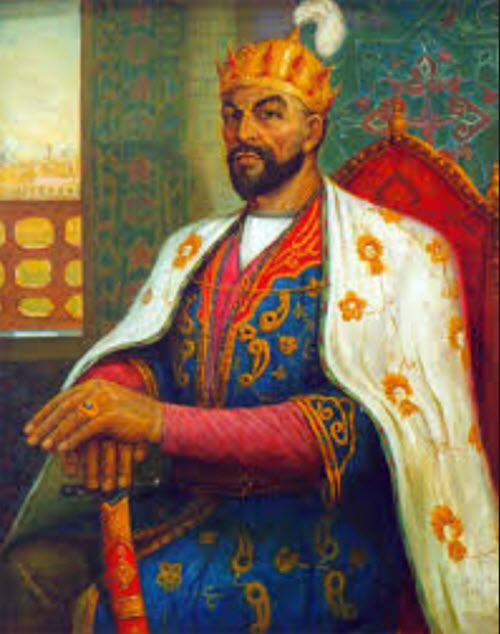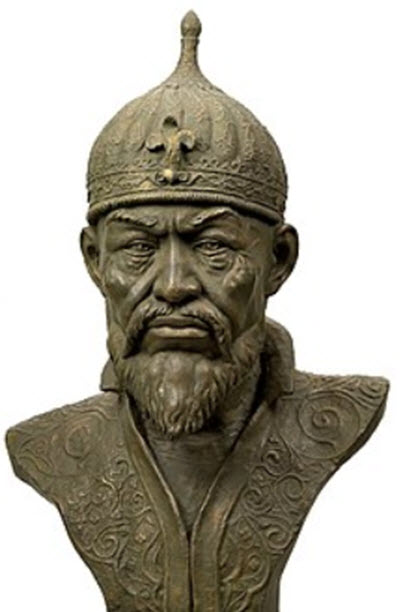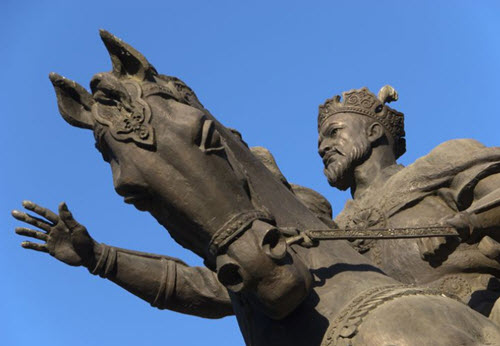Contents
Timur (9 April 1336 – 17 or 18 February 1405) was a Turco-Mongol conqueror, the founder of the Timurid Empire in Persia and Cental Asia, and the first ruler in the Timurid dynasty. In Turkic, timur means iron.
 In some sources, he is known as Temūr, Temür, Amir Timur, Timur-i lang, or Tamerlane. In Persian, Timur-i lang means Temur the Lame.
In some sources, he is known as Temūr, Temür, Amir Timur, Timur-i lang, or Tamerlane. In Persian, Timur-i lang means Temur the Lame.
Timur was the last of the great nomadic conquerors of the Euroasian Steppe, and his goal was a restoration of Genghis Khan’s great Mongol Empire. Gengis Khan, who had died in 1227, and Timur shared a common ancestor.
In his lifetime, Timur conquered more than anyone else except for Alexander the Great. Towards the end of his reign, Timur controlled all the remnants of the Chagatai Khanate, the Ilkhanatate and the Golden Horse, and he also attempted to restore the Yuan dynasty in China. His army included soldiers of several different ethnicities and was both well-known and much feared throughout Asia, Africa and Europe. It crossed Euroasia from Delhi to Moscow, and from the Tien Shan Mountains of Central Asia to the Taurus Mountains of Anatolia. According to modern-day scholars, Timur’s campaigns caused the death of an estimated 17 million people, which was roughly 5% of the world’s population at the time.
Timur’s empire set the stage for the rise of the more structured so called Gunpowder Empires of the 16th and 17th century.
One of the Europeans who wrote about Timur was the royal envoy Ruy Gonzalez de Clavijo, who was sent to visit Timur on behalf of the Spanish king Enrique III de Castilla. In Persia, Ali Sharaf ad-Din wrote a whole biography about Timur, and so did Ahmad ibn Arabshah for an Arabic audience.
About Timur
Timur was born at Kesh, a city located roughly 50 miles south of Samarkand, on 9 April 1336. His father was a lesser chief of the Barlas tribe, and through him, Timur claimed to be a descendant of Tumbinai Setsen, a male-line ancestor he shared in common with Genghis Khan.
Timur is described as tall and strongly built, with a big head and broad forehead. His skin was pale and ruddy, and he wore a full beard.
According to the biographer Sharaf ad-Din, Timur was injured by arrows while stealing sheep in his twenties, and this left him lame in the right leg and caused his right arm to be stiff for the rest of his life. Hence, his Persian name, Timur-i lang (Temur the Lame).
His lameness didn’t seem to slow him down, and before the age of 35 he was in control of all the lands that formed the heritage of Chagatai. After being proclaimed sovereign at Balkh, he turned Samarkand into his capital.
There is no evidence of Timur ever learning to read or write, but he spoke two or three languages, including Turkic and Persian, and he arranged to have history books read to him while he had dinner.
He is described as an intelligent man and also a great lover of art, including architecture and gardening. He loved to play chess, and also invented a more elaborate form of the game where twice the standard number of pieces are used on a board consisting of 110 squares. Today, we call this game Tamerlane Chess.
Religion
 The question of Timur’s own religious beliefs is a controversial one among scholars.
The question of Timur’s own religious beliefs is a controversial one among scholars.
He relied on Islamic symbols and language to bring legitimicy to his conquests, and often referred to himself as The Sword of Islam. He supported educational and religious Islamic institutions, and encouraged the Borjigin leaders to convert to Islam.
Some scholars have labeled hims a Shiite (Shia muslim) based on his veneration of the house of the Prophet and the genealogy on his tombstone where he claims to be a descendant of Ali. The presence of Shiites in Timur’s army might have added fuel to these conclusions, even though his army was far from homogenous.
His official religious counselor was not a Shiite but the Hanafite scholar Abd alJabbar Khwarazmi, and Timur described himself as a disciple of Sayyid Baraka – the holy man of Tirmidh. Timur’s personal religious practises seem to have included Turco-MOngolian shamanistic elements blended with the Sufi tradition. Timur is also famous for ordering the construction of a marvelous building at the tomb of Ahmad Yaassawi, a missionary credited for converting many nomads of the steppe to Folk Islam.
Building an Empire
Timur inherited a system of rulership that he used for both nomadic and settled populations. Compared to Gengis Khan, the control and use of settled populations was much more important to Timur.
Early in his career, Timur began using the epithet Sahib Qiran and symbolized it with three circlets that formed a triangle. The term, which was borrowed from astrology, translates as “Lord of the Fortunate Conjuncture”. For Timur, this expressed his aim to not just balance chiefs, nomads and settled populations, but also integrate them into a dynamic institutional system.
On 18 June, 1391, Timur’s army won the great Battle of Kanduzcha, and on July 28, 1402, Timur led his men to victory against the Ottoman army in Ankara.
His army
Timur’s army was organized into tumen, which were military units each comprised of 10,000 men.
The army was famous not just for being extremely fierce and violent, but also for its heterogenity. It included soldiers from Timur’s heartland as well as from more recently conquered lands, and was described by contemporary sources as a huge conglomeration of different people; people from nomadic groups and people from settled populations; Muslims and Christians, Moghuls as well as Anatolians, and various ethnicities such as Turks, Arabs, Tajiks, Georgians, Persians, and Indians. Among the tribes most loyal to Timur were the Barlas and the Jalayir.
Silk Road ambitions
Timur had a great interest in trade and wanted to reactive and restore the Silk Road. His ambition was to keep the Silk Road under his control, even though that ment having to go to war with various nations and empires located along this enormously long route from West to East.
China
 In 1395, one of Emperor Hung-wu’s embassies reached Samarkand and was promtly imprisoned by Timur. Emperor Hung-we, the first Ming ruler, had been sending out embassies to various former Yuan tributaries asking them to recognize Ming as their overlords. Timur had no intentions of bowing to Ming; on the contrary – he was plotting a campaign to seize control of that section of the Silk Road, restore Yuan to its former Mongol glory, and surpass Alexander the Great in his acomplishments as conqueror.
In 1395, one of Emperor Hung-wu’s embassies reached Samarkand and was promtly imprisoned by Timur. Emperor Hung-we, the first Ming ruler, had been sending out embassies to various former Yuan tributaries asking them to recognize Ming as their overlords. Timur had no intentions of bowing to Ming; on the contrary – he was plotting a campaign to seize control of that section of the Silk Road, restore Yuan to its former Mongol glory, and surpass Alexander the Great in his acomplishments as conqueror.
In 1402, Emperor Yung-lo succeeded Hung-wu as leader of the Ming. He was aware of Timur’s less than friendly intentions but did send an embassador to Samarkand. This embassador was imprisoned, just like the first one. In 1405, Yung-lo launched a series of naval expeditions to the west to esnure that China would not become isolated if Timur attacked from the west by land.
Now, Timur had been biding his time for several years and was anxious to get going. His generals advised him to stay in Samarkand until spring, but Timur refused. Instead, he wanted to start moving his troups north right away along the Jaxartes river and be ready to attack China as soon as spring came.
In early January 1405, Timur left Samarkand accompanied by a huge army. The exact date had been selected by his astrologers. At this point, he was already quite old, and too weak to walk. He didn’t even ride; he was carried in a litter. Still, the journey took its toll, and after reaching Utrar in late January, Timur’s health was in a very poor state. He didn’t continue farther than Utrar; he died there on 17 or 18 February 1405. His body was brought back to Samarkand and buried at the Gur-i-Mir.
In 1941, his body was exhumed by Russian scientist M.M. Gerasimov. After examining the skelleton, Gerasimov could confirm that it belonged to a man that had been roughly 173 cm tall, and who was a member of what was then referred to as the Mongoloid race. Gerasimov also confirmed the lameness.